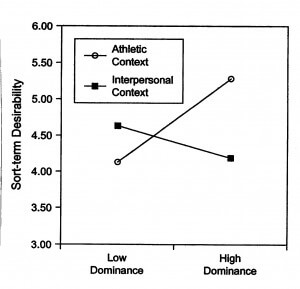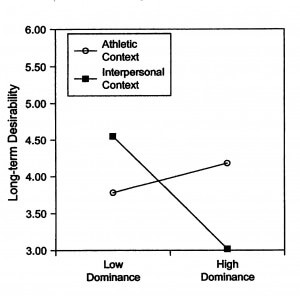In any discussion of what women want, no trait gets more attention than social status. Acknowledged as a key female attraction cue, it’s also frequently referred to as social dominance. It’s easy to see why. One need only look around to see that men in positions of leadership and social dominance are highly desired by women. Ogi Ogas, in his bestselling book A Billion Wicked Thoughts: What the World’s Largest Experiment Reveals About Human Desire, confirms its universal appeal:
Study after study has demonstrated the erotic appeal of male dominance. Women prefer the voices of dominant men, the scent of dominant men, the movement and gait of dominant men, and the facial features of dominant men…Scientists believe that the ventrolateral prefrontal cortex may be responsible for processing cues indicating social status or dominance, and it appears that almost all female brains are susceptible to dominance cues.
 Furthermore, social dominance is not conferred by women, it’s awarded by other men in a process of intrasexual competition for dominance and leadership. Men continually compete for dominance in social interactions with one another. The men who achieve the greatest rank among their peers may then display that dominance as a powerful advantage in attracting women for sex.
Furthermore, social dominance is not conferred by women, it’s awarded by other men in a process of intrasexual competition for dominance and leadership. Men continually compete for dominance in social interactions with one another. The men who achieve the greatest rank among their peers may then display that dominance as a powerful advantage in attracting women for sex.
On the other hand, women associate very masculine faces with negative traits such as coldness and dishonesty. Women also perceive very dominant males as more likely to cheat and divert resources away from the family. This may be of little or no concern to women who prioritize short-term mating. For long-term mating, however, the female is faced with the challenge of optimizing the combination of leadership and provider traits.
Until now, scientists have not understood how humans evolved to prioritize pair-bonding over promiscuity, a critical development that laid the foundation for the modern family. A new study proposes that it’s entirely attributable to female choice. Women evolved to prefer cooperative, emotionally nurturing providers over physically dominant males:
Pair bonding supplanted promiscuity in human evolution when faithful females began choosing good providers as mates, a study finds. Evolutionary biologists have struggled to explain how pair bonding and the nuclear family structure took root in humans, as primate groups typically establish dominance-driven hierarchies that restrict mating privileges to a few high-ranking males.
…Using simple mathematical models, Sergey Gavrilets revealed that the most commonly proposed theories for human pair bonding are biologically unrealistic. Then, incorporating among other factors the evolution of female choice and faithfulness, the researcher devised a model showing how pair bonding can represent a key adaptation underscoring the uniqueness of human evolution.
The author proposes that low-ranked males likely began attracting mates by focusing almost exclusively on becoming the best providers, a strategy which had the added benefits of enhancing female fertility and bolstering the survival of their offspring. Over evolutionary time, the model indicates that all but the highest-ranking males would shift to provisioning females who had evolved a high sense of fidelity. The findings reveal that female choice factored critically in human evolution.
That begs the obvious question – if women have evolved to prefer men who provide both intangible and tangible resources (dads) over less agreeable or nurturing mates (cads), why does research show that women reward dominant displays?
Why do women prefer dominant men?
Since the 1987 landmark study revealing the female preference for dominance in males, scholars have theorized that women would have preferred men most likely to provide them with resources such as food and protection from danger. In addition, the “sexy sons” hypothesis states that women would have been eager to pass along dominant genes to their own offspring.
Sadalla, Kenrick, and Vershure (1987) published evidence indicating that women prefer men who are high in dominance over men who are low in dominance as potential dates (i.e., potential short-term relationship partners) and rate them as more attractive.
It seems likely that Erik von Markovik, aka Mystery, who studied evolutionary psychology to codify Game, would have relied heavily on this study. Since his focus was on short-term rather than long-term mating, this research finding would have proved valuable and highly relevant to his efforts.
However, Snyder, Kirkpatrick, and Barrett (2008) questioned the validity of the original findings. They observed a lack of consensus among scholars regarding what comprises social dominance. They also wondered how female preferences differed for casual sex vs. marriage:
Since [Sadalla et al, 1987], despite numerous studies pointing to limitations of this result, it seems that a simplistic version of their conclusion— that ‘‘women prefer dominant mates’’—has become conventional wisdom in psychology and related fields.
We wish to reopen the analysis of this mate preference phenomenon for scholars of romantic relationships with the following goals.
First, we intend to clarify and reexamine Sadalla and colleagues’ (1987) initial findings. In the pursuit of this goal, we argue that there is a problematic lack of consensus regarding what dominance as a construct is and suggest that subsequent attempts to clarify Sadalla and colleagues’ work (Jensen-Campbell, Graziano, & West, 1995) were insufficient.
Second, we provide evidence suggesting that women’s preferences in regard to status are contingent on several factors, including (a) the distinction between prestige-based and dominance-based status, (b) the social context in which the behavior is observed, and (c) the particular dimension of desirability being assessed.
In their published paper The Dominance Dilemma, they shared results from three studies conducted with female students at UCLA and the College of William and Mary. For the purposes of these studies, they defined dominance as “forced or coerced leadership,” characterized by aggression and other domineering tactics in the pursuit of agentic self-interest. Dominance leads subordinates to submit to a dominant male via intimidation or fear. They tend to maintain greater physical distance from the dominant male and maintain less eye contact.
Conversely, prestige is defined as “freely conferred status” by peers in recognition of special abilities and skills. Peers benefit from association with skilled individuals, as it is more efficient to copy their expertise than engage in trial and error learning. The prestigious individual is honored, revered and praised by subordinates, and “respond[s] with self-deprecation. Prestigious individuals freely offer information and counsel. Because of this free exchange of status for information, prestigious individuals may appear to be more kind, generous, and willing to help than dominant individuals.”
The research by Snyder et al revealed several key findings:
- When given the choice between dominance and prestige, women demonstrate a clear preference for a high-prestige male over a high-dominance male.
- Women prefer low-dominance males for both long-term and short-term mating, but the preference is stronger when seeking a long-term partner.
- Women prefer high prestige partners over low prestige partners, and this preference is also stronger for long-term vs. short-term mating.
- Women find dominant behaviors attractive in the context of athletic competition, but penalize them for both short- and long-term mating.


In this light, distinguishing between dominance and prestige is essential to enhancing our understanding of female sexuality and attraction. Overall, the research suggests that women are not attracted to disagreeable males, i.e. jerks and assholes, they’re attracted to men who earn the respect and admiration of other men, and who display kindness and generosity. The degree to which women penalize dominance vs. prestige is contextual, based on their own mating priorities, i.e. short-term vs. long-term.
It should be noted that dominance and prestige are alternate, but not entirely mutually exclusive, pathways to social status. Ironically, fraternity membership and athletics may connote prestige rather than dominance, even as its members often prioritize casual sex and engage in dominant behaviors, particularly towards women.
Fraternities, which generally advertise themselves as offering both male camaraderie and access to high value females, are presumably selective in identifying males who can uphold or even improve the organization’s reputation. They court these males energetically, even arranging hookups for them in some cases.
The school athlete is perhaps best positioned to attract his female classmates, as he is rewarded with prestige for teamwork and excites female interest by displaying dominant behavior on the field.
Unfortunately for women, a male’s having achieved a high level of prestige is no guarantee of agreeable behavior with the opposite sex, particularly before he is fully mature. Indeed, he will be influenced heavily by his peer culture, which tends to prioritize douchiness, i.e. dominance, over “good guy” honesty and self-deprecation.
The implications for women are clear:
- Seek men who have earned prestige from their male peers via their abilities and skills.
- Judge a man by the company he keeps, and how much he is genuinely loved and respected by others.
- Avoid men who tend toward aggressive and controlling tactics, except on the playing field.
- Expect men engaging in casual sex rather than relationships to display more dominance, as it is less penalized in a short-term mating context.
- Men with earned prestige have much higher emotional intelligence than men with self-serving, agentic behaviors. Look for depth of emotional expression in the men you date. The emotions need not be focused on you, but a man should feel strong love and loyalty for the things and people he cares about.
- Graduate from college and date five years older!







